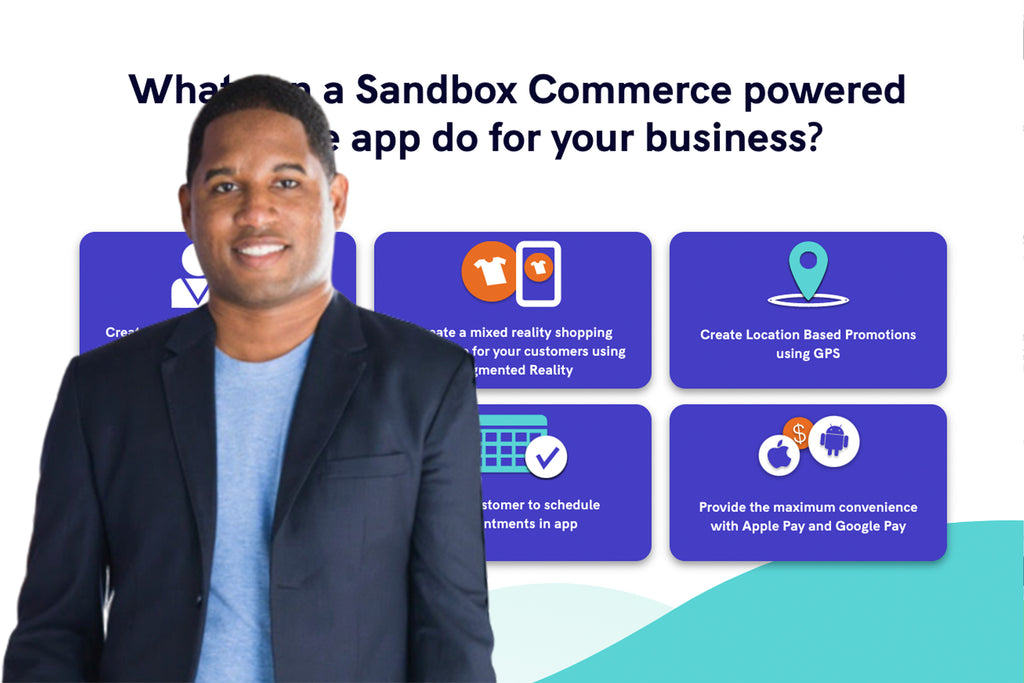The world of ecommerce is fast-paced, packed with new innovations, apps, tools, and more. And behind every development, there's always a brilliant creator. Today we're having a chat with one of those creators, Sterling Smith, founder of Sandbox Commerce.
Over the last 10 years, Sterling has worked for Walmart, Lockheed Martin, Booz Allen Hamilton, and currently resides in Austin, Texas. He is also an advisor & mentor to several technology startups in the retail tech and #nocode sectors...and is a semi-pro NBA2K player!
What does Sandbox Commerce do?
Sandbox Commerce is a no-code solution for online retailers to design and launch their own mobile app. Our tool seamlessly connects with Shopify, Big Commerce, and 3dCart to pull in and sync with a store’s entire inventory in real-time. We’re hoping to put powerful apps in the hands of small e-commerce stores who typically couldn’t justify the price of building their own iOS or Android app.
Who is Sandbox designed for? Do you need any coding experience to use it?
You don’t have to write a single line of code to customize an app! Our App Builder is a drag-and-drop interface that you can arrange and customize to your heart’s content. Users can easily customize fonts, colors and upload graphics to make the app look and feel like a natural extension of your brand.
Talk us through the process, how easy is it to get from signing up to use Sandbox to having a functioning, installed app on your store.
It can be boiled down to 3 easy steps….
Step 1 - Connect your store. We currently integrate with Shopify, 3dCart and Big Commerce. Store owners can connect their store and create an account with just a few clicks - no clunky API keys or anything like that. After connecting their store, their entire inventory is pulled into the app builder and stays in sync.
Step 2 - Customize your app. Using our drag-and-drop interface, you can easily set up the look of your app. You can use marquees to feature photos you would typically see at the top of a website. Flaunt new featured items or scroll through collections. The app is very customizable and merchants can upload photos, change fonts and button colors with ease.
Step 3 - publish your app! After you’ve designed an app, all you have to do is hit publish. Shortly after, our customer success team starts an internal QA process and they’ll reach forward with next steps. We’ve worked hard to establish a thorough customer success team who helps you launch the app, assists in creating campaigns and shares proven tactics to jump-start the number of downloads.
How do Shopify merchants benefit from having a mobile app?
I don’t think there’s a silver bullet answer to this question since needs vary so much from retailer to retailer. Some retailers are purely interested in expanding brand awareness and just having a mobile app on a customer’s phone is enough for them. Others are looking for more intimate conversation channels and really leverage push notifications to promote campaigns. We have retailers who are purely focused on conversion and see benefits from enhanced checkout experiences with Apple Pay and other streamlined shopping features.
There’s a lot of benefits to having a mobile app. Our goal is to help small and medium-sized retailers sell online as if they’re a billion-dollar company like Nike or Target.
What makes for a successful mobile app experience?
Finding the answer to this was one of the questions that took the longest for us to solve. Responsive websites just keep getting better and better so we had to focus on features that a website will never be able to achieve. Ultimately, it’s the ease of use and speed to checkout. Apps are faster to load and checkout with Apple Pay and stored account information and more immersive with features like AR.
And on the other side of things, what common pitfalls should merchants avoid when creating a mobile app?
I’d warn some merchants of being too early. You have to ensure that your core sales channels are generating business before they expand to a mobile app. It won’t solve all of your issues for conversion and traffic but can be an essential asset for brands that have a solid grip on their basic operations.
The mobile app is just one of your products. Tell us about your other product.
Sandbox Commerce also has a product for Shoppable Instagram. This product connects with your Shopify store and your Instagram account to bring the features of Shoppable Galleries to your website. We noticed our customers spend so much time curating their Instagram feed, it felt like a no-brainer to give them the ability to post a code snippet anywhere on their website, blog, newsletter or Sandbox Powered App.
Where can customers reach you for more information about Sandbox Commerce?
For any questions, you can reach out to info@sandboxcommerce.com. For anyone who thinks any of our products might be a good fit for them, I’d encourage you to sign up for a 7-day free trial. For merchants who sign up for the App Builder, it’s worth noting that our Customer Success team will build out the first version of your app for no additional cost!.
Be sure to check out Sandbox Commerce on their website, and follow them on Twitter, Facebook, and Instagram. You can also find Sterling over on his Twitter account.
This week's Commerce Tea podcast episode also features an interview with Sterling, you can find that here.

